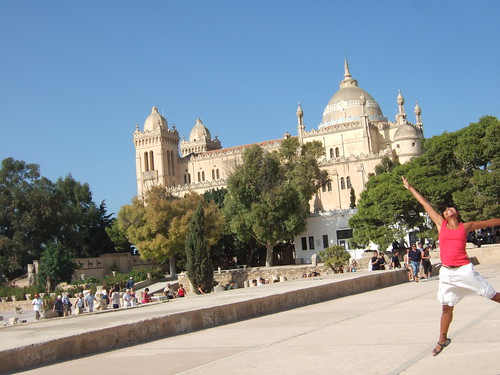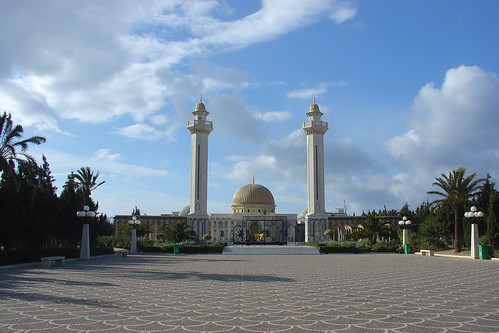
The Franco-Tunisian Arabic (officially Republic of Tunisia) attracts with its three thousand years of history to hundreds of visitors per year. This beautiful country lies between two completely different landscapes, embracing the diversity of the Sahara desert in Africa and the Mediterranean coast and surrounded by Algeria and Libya to the west to the east and south. Going north from the capital city will arrive at the fabled ruins of Carthage, where time seems to take us back several centuries and a trip to the glorious past.
Weather
The Mediterranean climate of Tunisia makes it a paradise of warm waters and sunny days cooled by gentle breezes throughout the year. Summers are hot and dry, while winter is more humid. The interior is characterized by higher rainfall in winter and higher temperature during the summer. The days are cooler between October and May, while the highest heat produced in July and August.
The cooler months or the spring (March-May), when wildflowers adorn the landscape, are the best times to visit the country. In January and February the coldest months rainy, the hotel prices down slightly, while during the peak increases much more, it is difficult to rent cars and museums and markets are full.
Important Information
The only people for whom the entry requirement is a valid passport are nationals of Argentina, Chile and the EU. The maximum stay allowed for visitors is 90 days.
The official currency is the Tunisian dinar and traveler’s checks are widely received. In banks and hotels, you can change foreign currency dinars. Aromatic ATMs are abundant in most cities and tourist resorts. It also accept major credit cards (Visa, MasterCard, American Express). Before leaving the country must be changed throughout the remainder of Tunisian currency, since it is impossible to change it on the outside.
While Tipping is not required, are always welcome samples of gratitude. It is customary to leave a 10% to waiters and doormen.
Regarding health, there are no serious risks to those who visit Tunisia, however, all visitors coming from infected areas will be asked a certificate of vaccination against yellow fever. Visitors can suffer from diarrhea or parasitic if you’re not careful with what is consumed, it is recommended to limit bottled water and food well cooked. It is essential to hire a medical insurance for the trip, the cost of medical treatment is high and should be paid just received. Some medicines are not available, so it is recommended to take the necessary amount of personal medication.
Where to go
Best of Tunisia is located in the medina, the historic and cultural city. Some of the points of interest are the mosques and Zituona Youssef Dey on Souq el-Attarine, perfumer and Souq Souq el-Berka, where Muslims pirates sold slaves. It is also interesting to visit the huge mausoleum Tourbet el-Bey, the center for the arts and popular traditions Dar Ben Abdallah and houses of Dar el-Haddad. Another place that focuses more attractive is the ville nouvelle, afrancesado and the modern sector of the city, where you can see, for example, the eclectic Cathedral of St. Vincent de Paul. At the center is located west of the Bardo Museum, located in the former official residence of the Beysen husseinitas and home to several art collections from different periods. Former El Jem Coliseum, about the same size as that of Rome, built between 230 and 238 AD, is located on a plateau at 210 km south of the capital.
The attractive Tozeur, 435 km south of the capital, is one of the cities most visited by travelers interested in the labyrinthine old town, Ouled el-Hadef, dating from the fourteenth century AD, and the interesting Museum and Dar Charait terraces of the large palm Chott el-Kebili.
In the legendary Carthage, six points of interest are scattered and far enough between them, so please allow time and be prepared to walk a lot. Byrsa hill, whose foot is the enormous Cathedral of St. Louis, is the best starting point. Behind the cathedral is the National Museum, with permanent displays and exhibitions Punic that are constantly being renewed. On the western side of a hill is the amphitheater, although today is very small, was one of the largest in the Roman Empire. Amphitheater andalusia northeast are the ruins of tanks, of difficult access. In front of the sea and south of the hill are the baths of Antonio impressive archaeological park and the neighborhood of Magon. Another good option is to visit the shrine of Tofet, a cemetery with a sacrificial enclosure.
A 105 km from the capital and overlooking the valley of Oued Kalle are the Roman ruins of Dougga, the best preserved of the country. Among the points of interest include the old theater where they celebrate the Festival of Dougga, Place of the Winds and the Temple of Saturn. Other good views are the house of Dionysus and Odysseus, who once was a luxurious residence and the Capitol, one of the most imposing in the country.

The former troglodyte village of Matma, the houses still retain groundwater (Berber), is located in the coastal area, 400 km south of Tunis. This is one of the most sought after tourist destinations in the country and one of the sites that was filmed Star Wars. Their homes with patios dug under the earth and its lunar landscape make Matma an ideal place to escape for a while from what we know and enjoy a walk in a different universe.
Besides being an important port, Susa is the third largest city in the country and therefore the most sought after by tourists. To the north lies a beach that leads to the tourist enclave of Port el-Kantaoui. In the walled medina, you can visit a number of important monuments, in addition to the Museum of Susa, the Grand Mosque sober and strong Ribat.

Festivals
The Islamic calendar is governed by the lunar months, so you have a difference of 11 days with the Gregorian. For this reason it is necessary to ensure the dates of the celebrations for the year in which you want to visit the country.
Some of the most important festivals are the Ras as-Sana (New Year), the Ramadhan fasting month which culminates with the feast of Eid al-Fitr. Also important are the Moul an-Nabi, which commemorates the anniversary of Muhammad, and the time of Eid al-Adha, the pilgrimage to Mecca.
A mid-year are interesting festivals: the International Symphonic Music El Jem, the Carthage International Film Festival (only in odd years), the Dougga and Carthage.
Welcome to the land of the dunes!
Leave a Reply
You must be logged in to post a comment.
Recent Comments